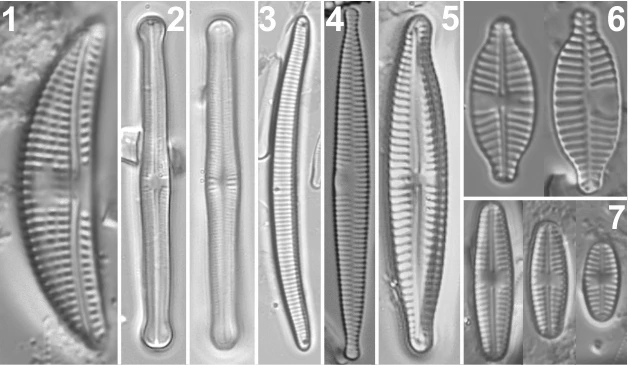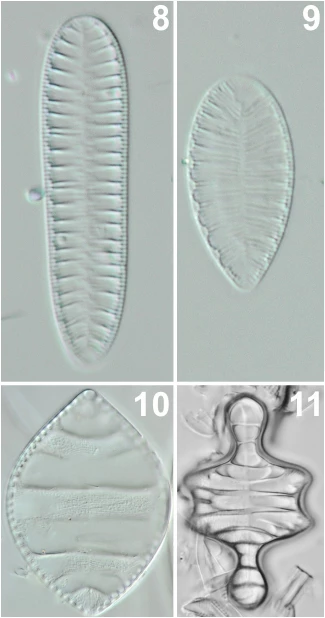Diatom Flora of Britain and Ireland
Fig. 1. 1=Amphora macedoniensis, 2=Achnanthidium caledonicum, 3=Eunotia juettnerae, 4=Fragilaria battarbeeana, 5=Gomphonema varioreduncum, 6=Planothidium reichardtii, 7=Sellaphora saugerresii, (light microscopy).
Fig. 2. 8=Surirella pinnata, 9=Surirella subsalsa, 10=Cymatopleura hibernica, 11=Tetracyclus emarginatus, (light microscopy).
Fig. 3. Species in nutrient-rich waters: 12=Cocconeis pediculus, 13=Navicula gregaria, 14=Rhoicosphenia abbreviata, 15=Nitzschia palea; species in acidified waters: 16=Eunotia exigua, 17=Eunotia incisa, 18=Tabellaria flocculosa, 19=Pinnularia subcapitata, (scanning electron microscopy).
Fig. 4. 20=Cocconeis neothumensis, 21=Eunotia serra, 22=Staurosirella rhomboides, 23= Semiorbis hemicyclus, (scanning electron microscopy).
What are diatoms?
Diatoms are microscopic, single-celled algae which live in fresh and brackish waters, the sea, and moist terrestrial habitats. They are the most species-rich group of algae. It is estimated that between 100,000 and 2 million species exist and new species are frequently discovered.
Why are diatoms important?
Diatoms are important algae in the environment producing oxygen and providing a source of food for many organisms. They are also sensitive to many environmental conditions, for example different species vary in their preference for nutrient concentrations, acidity, salinity, sediment load, flow regime and temperature. Hence, diatoms are good bioindicators providing us with information about the environment and the health of aquatic ecosystems. Many methods to monitor environmental change have been developed and diatom indices such as the UK’s Trophic Diatom Index (TDI) and the Diatom Acidification Metric (DAM) are regularly used by environmental researchers and the environment agencies to monitor water quality and the ecological status of our freshwater ecosystems (Kelly et al. 2020, Jüttner et al. 2021).
What makes diatoms unique?
Diatoms have a unique feature, a cell wall that is made of silica, and its shape and intricate morphological pattern are used to identify the different species in microscopy.
How can we help identify diatoms?
The website Diatom Flora of Britain and Ireland is a major project facilitating the identification of diatoms using their morphological features. The project is led by Amgueddfa Cymru’s diatom curator Dr Ingrid Jüttner, funded by the British Phycological Society and in-kind contributions from the participating experts and institutions. It consists of a web-based diatom flora and peer-reviewed publications providing a taxonomic review of diatoms from freshwater, brackish and subaerial habitats in Britain and Ireland.
https://naturalhistory.museumwales.ac.uk/diatoms/
https://www.researchgate.net/profile/Ingrid-Juettner
An estimated several thousand species of freshwater diatoms occur in Britain and Ireland. The last decade has seen many taxonomic revisions, including those in common genera including Amphora, Achnanthidium, Eunotia, Fragilaria, Gomphonema, Planothidium and Sellaphora and some rarely recorded species in these genera are now documented on the diatom flora website (Fig. 1). It is likely that many new diatom species in Britain and Ireland are yet to be discovered, especially in under recorded habitats such as remote upland freshwaters.
Additionally, we began to study historic material that was used by earlier diatom researchers to describe new species, for example the collections by William Smith, one of the most prominent diatomists in the 19th century. His major contribution to diatom research was the publication of the Synopsis of the British Diatomaceae (1853, 1856), one of the first systematic diatom monographs, and still an important resource for diatom identification. His slide collections and original type material of the species he described are kept in Meise Botanic Garden, Belgium (Hoover 1976), in the Natural History Museum, London (Smith 1859), and in the Royal Botanical Garden of Edinburgh. Smith’s collections comprise more than 1200 samples from all over Britain, but many species in the British flora described by Smith are poorly documented and will be the subject of our studies in the future (Fig. 2).
Why is the Diatom Flora of Britain and Ireland website so important?
Recent taxonomic revisions and studies on species distribution (e.g., Novais et al. 2015, Levkov et al. 2016, Wetzel et al. 2019, Jüttner et al. 2022, Van de Vijver et al. 2022) have led to improved understanding of species taxonomy and ecology. These studies were published in a range of scientific journals and books making it difficult for practically oriented users of diatom monitoring methods, students and researchers not involved in taxonomic research to keep up to date. Hence, the freely available Diatom Flora of Britain and Ireland website, summarising the most recent progress in diatom taxonomy, is a valuable tool that supports the use of diatoms in a wide array of disciplines and applications.
Currently 334 species in 66 genera are published online. All taxa are documented using light microscopy observations, but many are also illustrated with scanning electron microscopy pictures, and some with images of the living cells. All taxa are accompanied by morphological descriptions and a list of key references. Many of the published species are from freshwaters impacted by eutrophication or acidification and are frequently encountered during environmental monitoring of rivers and lakes (Fig. 3).
More recently, we found and illustrated several rare species from unpolluted freshwaters (Fig. 4). However, the floras of semi- or near-natural aquatic habitats for example those typical in bogs, upland lakes, headwater streams and springs remain poorly represented and will be a focus of our work in the future. Unpolluted freshwaters can harbour high numbers of endangered taxa (Cantonati et al. 2022) and a better understanding of the flora of these unique wetlands is important and can support projects that assess environmental change in threatened habitats and support ecological restoration work.
References
Cantonati M., Hofmann G., Spitale D., Werum M., Lange-Bertalot H. 2022. Diatom Red Lists: important tools to assess and preserve biodiversity and habitats in the face of direct impacts and environmental change. Biodiversity and Conservation 31: 453–477. https://doi.org/10.1007/s10531-021-02339-9
Hoover, R.B. 1976. Inventory of the original typical collection of the Reverend William Smith (1808–1857). Types du Synopsis of British Diatomaceae. tt. [i]–xlv, 1–106, 11 plât. Antwerp: Koninklijke Maatschappij voor Dierkunde van Antwerpen met de medewerking van de Koninklijke Albert 1 en het Stadsbestuur van Antwerpen.
Jüttner I., Kelly M.G., Evans S., Probert H., Orange A., Ector L., Marsh-Smith S. 2021. Assessing the impact of land use and liming on stream quality, diatom assemblages and juvenile salmon in Wales, United Kingdom. Ecological Indicators 121, 107057. https://doi.org/10.1016/j.ecolind.2020.107057
Jüttner I., Hamilton P.B., Wetzel C.E., Van der Vijver B., King L., Kelly M.G., Williams D.M., Ector L. 2022. A study of the morphology and distribution of four Achnanthidium Kütz. species (Bacillariophyta), implications for ecological status assessment, and description of two new European species. Cryptogamie Algologie 43(10): 147–176. https://doi.org/10.5252/cryptogamie-algologie2022v43a10
Kelly M.G., Phillips G., Juggins S., Willby N.J. 2020. Re-evaluating expectations for river phytobenthos assessment and understanding the relationship with macrophytes. Ecological Indicators 117, 106582. https://doi.org/10.1016/j.ecolind.2020.106582
Levkov Z., Mitić-Kopanja D., Reichardt E. 2016. The diatom genus Gomphonema from the Republic of Macedonia. Diatoms of Europe Vol. 8. Koeltz Botanical Books, Oberreifenberg, 552 tt.
Novais M.H., Jüttner I., Van de Vijver B., Morais M.M., Hoffmann L., Ector L. 2015. Morphological variability within the Achnanthidium minutissimum species complex (Bacillariophyta): comparison between the type material of Achnanthes minutissima and related taxa, and new freshwater Achnanthidium species from Portugal. Phytotaxa 224(2): 101–139. https://doi.org/10.11646/phytotaxa.224.2.1
Smith W. 1853. A Synopsis of the British Diatomaceae. Vol.1. John Van Voorst, London, 89 tt., 31 plât.
Smith W. 1856. A Synopsis of the British Diatomaceae. Vol.2. John Van Voorst, London, 107 tt., 67 plât.
Smith W. 1859. List of British Diatomaceae in the Collection of the British Museum. Taylor and Francis, London, 55 tt.
Van de Vijver B., Williams D.M., Kusber W.-H., Cantonati M., Hamilton P.B., Wetzel C.E., Ector L. 2022. Fragilaria radians (Kützing) D.M.Williams et Round, the correct name for F. gracilis (Fragilariaceae, Bacillariophyta): a critical analysis of this species complex in Europe. Fottea 22(2): 256–291. https://doi.org/10.5507/fot.2022.006
Wetzel C.E., Van de Vijver B., Blanco S., Ector L. 2019. On some common and new cavum-bearing Planothidium (Bacillariophyta) species from freshwater. Fottea 19(1): 50–89. https://doi.org/10.5507/fot.2018.016



